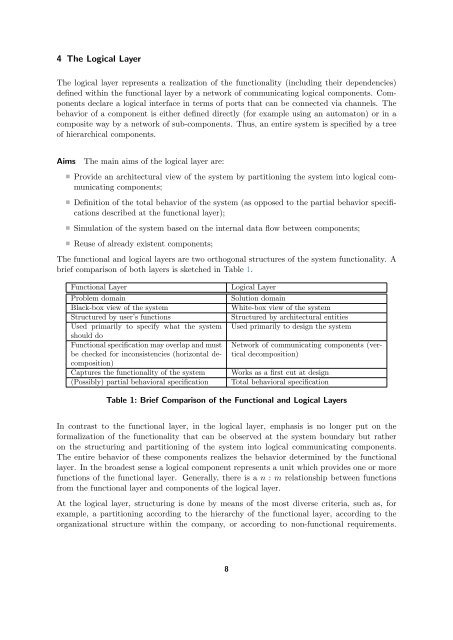SPES 2020 Deliverable D1.2.A-1 Abstraction Layers
SPES 2020 Deliverable D1.2.A-1 Abstraction Layers
SPES 2020 Deliverable D1.2.A-1 Abstraction Layers
You also want an ePaper? Increase the reach of your titles
YUMPU automatically turns print PDFs into web optimized ePapers that Google loves.
4 The Logical Layer<br />
The logical layer represents a realization of the functionality (including their dependencies)<br />
defined within the functional layer by a network of communicating logical components. Components<br />
declare a logical interface in terms of ports that can be connected via channels. The<br />
behavior of a component is either defined directly (for example using an automaton) or in a<br />
composite way by a network of sub-components. Thus, an entire system is specified by a tree<br />
of hierarchical components.<br />
Aims The main aims of the logical layer are:<br />
Provide an architectural view of the system by partitioning the system into logical communicating<br />
components;<br />
Definition of the total behavior of the system (as opposed to the partial behavior specifications<br />
described at the functional layer);<br />
Simulation of the system based on the internal data flow between components;<br />
Reuse of already existent components;<br />
The functional and logical layers are two orthogonal structures of the system functionality. A<br />
brief comparison of both layers is sketched in Table 1.<br />
Functional Layer Logical Layer<br />
Problem domain Solution domain<br />
Black-box view of the system White-box view of the system<br />
Structured by user’s functions Structured by architectural entities<br />
Used primarily to specify what the system Used primarily to design the system<br />
should do<br />
Functional specification may overlap and must<br />
be checked for inconsistencies (horizontal de-<br />
composition)<br />
Network of communicating components (vertical<br />
decomposition)<br />
Captures the functionality of the system Works as a first cut at design<br />
(Possibly) partial behavioral specification Total behavioral specification<br />
Table 1: Brief Comparison of the Functional and Logical <strong>Layers</strong><br />
In contrast to the functional layer, in the logical layer, emphasis is no longer put on the<br />
formalization of the functionality that can be observed at the system boundary but rather<br />
on the structuring and partitioning of the system into logical communicating components.<br />
The entire behavior of these components realizes the behavior determined by the functional<br />
layer. In the broadest sense a logical component represents a unit which provides one or more<br />
functions of the functional layer. Generally, there is a n : m relationship between functions<br />
from the functional layer and components of the logical layer.<br />
At the logical layer, structuring is done by means of the most diverse criteria, such as, for<br />
example, a partitioning according to the hierarchy of the functional layer, according to the<br />
organizational structure within the company, or according to non-functional requirements.<br />
8
















